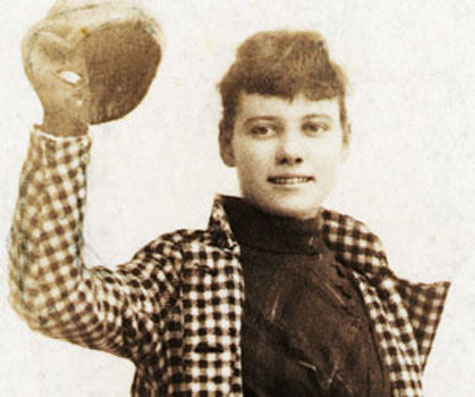
Amelia, of course, did pay the ultimate sacrifice when attempting to cross the Pacific.
I’m mentioning these women because I write about feisty females in the early twentieth century. Not that Molly Murphy is anything as glamorous as an aviatrix (as they were then known). But she’s a female detective—a profession definitely thought then to be an unsuitable job for a woman. I get letters telling me that no woman could really have done the things that Molly does. Women at the time were helpless creatures, dainty, wafting their smelling salts.
I’m pleased to reply that there were plenty of women doing what Molly does and more. The easiest ones to quote are Sabella Goodwin, who was the first female police detective with the NYPD, and Nellie Bly, who was constantly putting her life in danger as an investigative reporter and who beat Phileas Fogg’s record by going around the world in seventy-two days. And they were not unique in their daring and bravery. Gertrude Bell was exploring the Middle East, becoming the only one the Arabs would trust and eventually founding the state of Iraq. Louise Boyd was mounting an expedition to the North Pole. Isabella Byrd was traveling alone around the world and writing about it.
And think how difficult it must have been for women to succeed in anything in those days. Not just because men believed women belonged at home, but because of the way women had to dress. You try catching a murderer (or fleeing from one) when dressed in long, tight, cumbersome skirts, high necks, tight sleeves. Not to mention the dreaded corset that did not allow women to breathe properly and often led to fainting. Women succeeded in spite of their restrictions and restrictive clothing. And yet, if you ask anyone to talk about pioneers and explorers of the early twentieth century, I doubt if a woman’s name will come up.
Why is this? Maybe because history is written by men? So, in a small way, my books are showcases of what women were really contributing to society. They highlight the suffrage movement, women scientists, and of course daring women who crossed boundaries.
Let’s give three cheers for those daring young women in their flying machines, who shattered barriers, who closed their ears to criticism and prejudice, and did the most amazing things!
Rhys Bowen currently writes two mystery series: the atmospheric Molly Murphy novels about a feisty Irish immigrant in 1900s New York City, and the funny and sexy Royal Spyness mysteries about a penniless minor royal in 1930s Britain. Her bestselling books have garnered starred reviews, as well as a variety of nominations and awards. Born in England, she divides her time between California and Arizona, but may also be found lurking online at Jungle Red Writers, on Facebook, and tweeting @RhysBowen.

I’ve always been deeply impressed by pictures of Nellie Bly in her traveling costume, because of the corset. She went around the world in that? She’s a better woman than I am.
Yes, Rhys, the corsets! My God, how did they accomplish anything beyond fainting away in those? I love to read the letters, diaries, and biographies of the many women explorers of that time, as well. Stanley and Livingstone weren’t the only ones out there in the unexplored regions of the world.